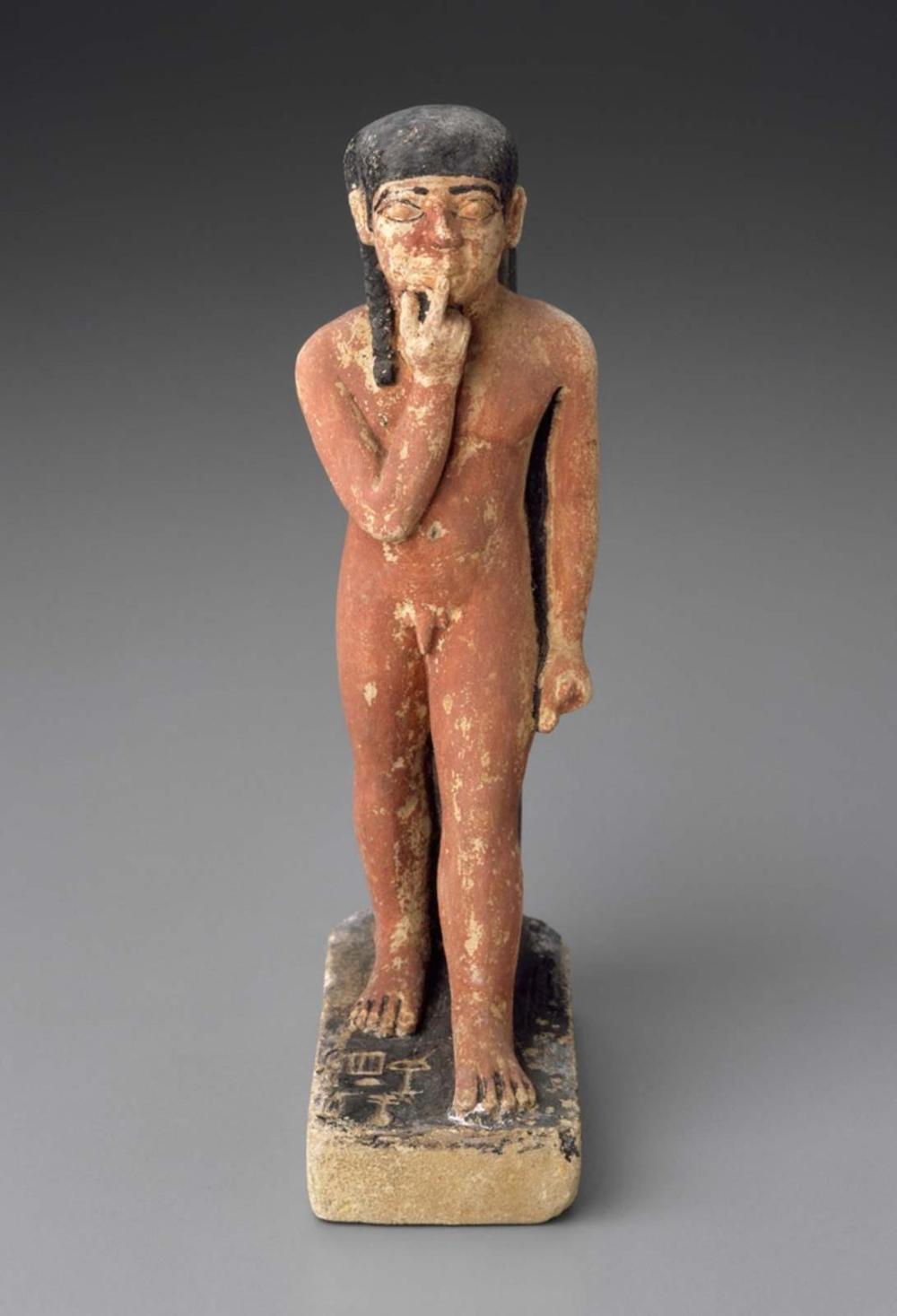Advanced Search
Statuette of Ptahneferti as a young boy
Egyptian
Old Kingdom, Dynasty 5
2465–2323 B.C.
Findspot: Egypt, Giza, tomb G 2009
Medium/Technique
Painted limestone
Dimensions
Height: 18 cm (7 1/16 in.)
Credit Line
Harvard University—Boston Museum of Fine Arts Expedition
Accession Number06.1881
CollectionsAncient Egypt, Nubia and the Near East
ClassificationsSculpture
In Egyptian art, strict rules dictated not only how adult figures should be represented, but children as well. In sculpture, boys and girls alike were shown naked before they reached puberty, touching their right index finger to their lips. Particularly in the Old Kingdom, they have their hair braided in a single lock on the right side. The boy shown here is Ptahneferty, according to the inscription on the front of his right foot. Such a statue of a child alone is rare - more frequently, children were represented with their parents. It is possible, however, that Ptahneferty was already an adult when this sculpture was commissioned. Not only is he named, but his title, "craftsman," is indicated as well.
Although Ptahneferty's body displays the pudginess typical of depictions of children of the time, his stance, with his left foot forward and left arm held rigidly at his side, is that of an adult man. The paint, so marvelously preserved, also shows him with the red skin color of adult males. The sculpture's base and back pillar are painted black, making those areas recede and calling attention to the figure itself. The face is emotionless, with large eyes, straight mouth, and pug nose. Like sculptures of adults in Egypt, what is depicted here represents an ideal rather than reality. In an Egyptian winter, it would have been far too cold for a child to go without clothes, and child-size garments preserved in tombs show that they did not. Like children everywhere, they played with toys, were protected by amulets, and assisted their parents.
Although Ptahneferty's body displays the pudginess typical of depictions of children of the time, his stance, with his left foot forward and left arm held rigidly at his side, is that of an adult man. The paint, so marvelously preserved, also shows him with the red skin color of adult males. The sculpture's base and back pillar are painted black, making those areas recede and calling attention to the figure itself. The face is emotionless, with large eyes, straight mouth, and pug nose. Like sculptures of adults in Egypt, what is depicted here represents an ideal rather than reality. In an Egyptian winter, it would have been far too cold for a child to go without clothes, and child-size garments preserved in tombs show that they did not. Like children everywhere, they played with toys, were protected by amulets, and assisted their parents.
DescriptionIn Egyptian art, strict rules dictated not only how adult figures should be represented, but children as well. In sculpture, boys and girls alike were shown naked before they reached puberty, touching their right index finger to their lips. Particularly in the Old Kingdom, they have their hair braided in a single lock on the right side. The boy shown here is Ptahneferty, according to the inscription on the front of his right foot. Such a statue of a child alone is rare - more frequently, children were represented with their parents. It is possible, however, that Ptahneferty was already an adult when this sculpture was commissioned. Not only is he named, but his title, "craftsman," is indicated as well.
Although Ptahneferty's body displays the pudginess typical of depictions of children of the time, his stance, with his left foot forward and left arm held rigidly at his side, is that of an adult man. The paint, so marvelously preserved, also shows him with the red skin color of adult males. The sculpture's base and back pillar are painted black, making those areas recede and calling attention to the figure itself. The face is emotionless, with large eyes, straight mouth, and pug nose. Like sculptures of adults in Egypt, what is depicted here represents an ideal rather than reality. In an Egyptian winter, it would have been far too cold for a child to go without clothes, and child-size garments preserved in tombs show that they did not. Like children everywhere, they played with toys, were protected by amulets, and assisted their parents.
Although Ptahneferty's body displays the pudginess typical of depictions of children of the time, his stance, with his left foot forward and left arm held rigidly at his side, is that of an adult man. The paint, so marvelously preserved, also shows him with the red skin color of adult males. The sculpture's base and back pillar are painted black, making those areas recede and calling attention to the figure itself. The face is emotionless, with large eyes, straight mouth, and pug nose. Like sculptures of adults in Egypt, what is depicted here represents an ideal rather than reality. In an Egyptian winter, it would have been far too cold for a child to go without clothes, and child-size garments preserved in tombs show that they did not. Like children everywhere, they played with toys, were protected by amulets, and assisted their parents.
ProvenanceFrom Giza, tomb G 2009. 1906: excavated by the Harvard University-Museum of Fine Arts Expedition; 1906: assigned to the MFA by the Egyptian government.
(Accession Date: November 8, 1906)
(Accession Date: November 8, 1906)







